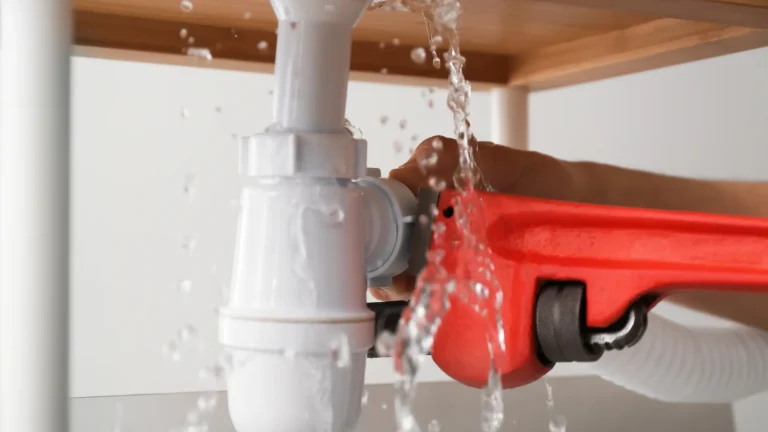A slow, draining, or smelly kitchen sink can turn your cooking space into a frustration zone. Over time grease, food particles and soap scum build up in your kitchen sink drain pipe and can cause clogs, odors and even plumbing issues. The good news is you can deep clean your kitchen drain and keep it running smoothly, all without harsh chemicals. In this guide, we’ll show you how to clean Kitchen Sink Drain Pipe, remove food buildup, clear grease, and deodorize your kitchen sink. We’ll also cover when to call a professional plumber.
Why You Should Clean Your Kitchen Sink Drain Regularly
Your kitchen sink drain pipe is a workhorse, handling everything from the dishwasher to food scraps. Without regular cleaning, you may face:
- Slow-draining sinks
- Foul odors
- Stubborn clogs
- Bacteria and mold growth
Regular maintenance helps prevent these issues and extends the life of your plumbing.
Signs Your Kitchen Sink Drain Needs Cleaning
Before you start, look for these signs:
- Water drains slowly (fix slow-draining sink)
- Odors linger around the sink
- Gurgling sounds as water drains
- Standing water in the sink basin
- Frequent clogs, despite careful use
If you notice any of these, it’s time to clean your kitchen drain deeply.
What You’ll Need
Gather these supplies before you start:
- Baking soda
- White vinegar
- Boiling water
- Dish soap
- Salt (optional)
- Plunger
- An old toothbrush or small scrub brush
- Rubber gloves
- Bucket and towels
- Pipe wrench (for deeper cleaning)
- Flashlight
Step-by-Step: How to Clean Kitchen Sink Drain Pipe
1. Clear the Sink and Remove Debris
Remove any dishes and visible food scraps from the sink. Wipe down the basin and around the drain opening.
2. Flush with Boiling Water
Pour a kettle of boiling water slowly down the drain. This will loosen the grease and soap scum, making the next steps more effective.
3. Use a Homemade Drain Cleaner
A homemade drain cleaner is safe, effective, and eco-friendly. Here’s a classic method:
Vinegar and Baking Soda Drain Solution
- Pour 1/2 cup of baking soda directly into the drain
- 2. Follow with 1 cup of white vinegar. You’ll hear fizzing – this is normal!
- Cover the drain with a stopper or a plate for 10-15 minutes to trap the reaction inside the pipe.
4. Plunge the Drain (If Needed)
If water is still draining slowly, try plunging:
- Fill the sink with a few inches of water.
- Place a plunger over the drain and pump hard.
- Remove the plunger and see if the water drains faster.
5. Remove and Clean the Trap (P-Trap) for Deep Cleaning
For stubborn clogs or to deep clean your kitchen sink:
- Put a bucket under the sink to catch water.
- Use a pipe wrench to loosen the slip nuts on the P-trap (the U-shaped pipe under the sink).
- Remove the trap and empty it into the bucket.
- Scrub the trap with dish soap and an old toothbrush to remove food buildup and grease.
- Rinse and reattach the trap, making sure all connections are tight.
Always wear rubber gloves and have towels handy for spills.
6. Deodorize Your Kitchen Sink
To deodorize kitchen sink drains, repeat the vinegar and baking soda solution monthly. You can also:
- Drop a few lemon or orange peels into the drain (if you have a garbage disposal).
- Rinse with hot water to keep things fresh.
How to Clean a Garbage Disposal Safely
If you have a sink with a garbage disposal, it needs to be cleaned, too:
- Turn off the power (unplug or switch off at the breaker).
- Remove any visible debris with tongs (never use your hands).
- Pour in 1/2 cup baking soda and 1 cup vinegar. Let it fizz for 10 minutes.
- Rinse with boiling water.
- Grind ice cubes and citrus peels to sharpen blades and deodorize.
Tips to Prevent Future Clogs
- Don’t pour grease or oil down the drain (it solidifies and causes blockages).
- Use a sink strainer to catch food scraps.
- Run hot water after each use to flush away residue.
- Clean sink drains with baking soda and vinegar monthly.
- Don’t overload the garbage disposal; feed scraps slowly.
Safety Precautions
- Always wear gloves to protect your hands from hot water and debris.
- Never mix commercial drain cleaners with homemade solutions—they can create dangerous fumes.
- If you remove the P-trap, make sure all connections are secure before using the sink again.
When to Call a Plumber
DIY methods work for most minor clogs and odors. But if: Water is backing up into other drains (dishwasher or bathroom sink).
- You see leaks under the sink.
- The clog is in the main drain line.
- DIY doesn’t work.
A professional plumber has the tools to fix kitchen sink drains and more.
